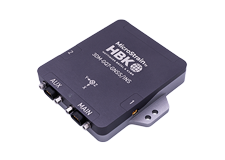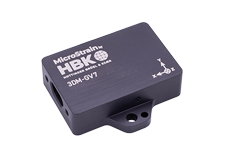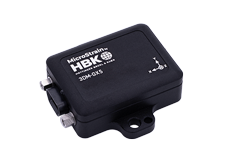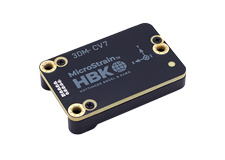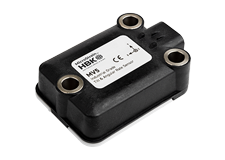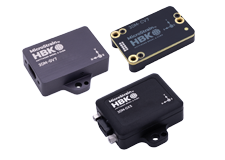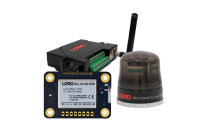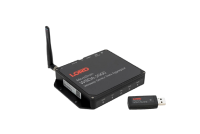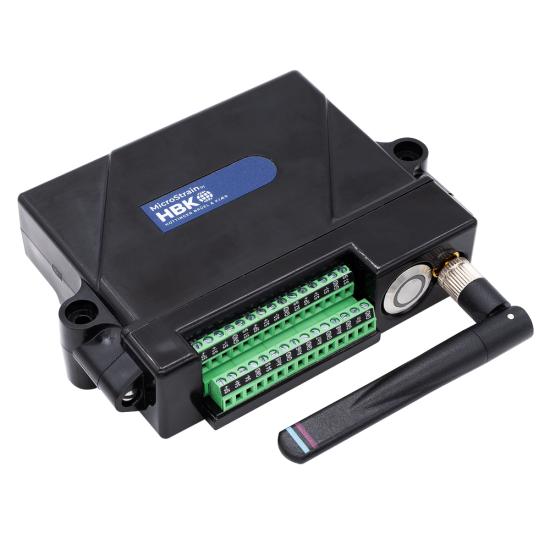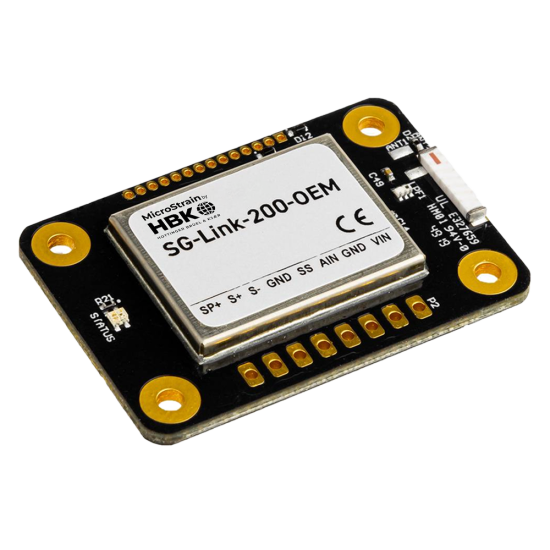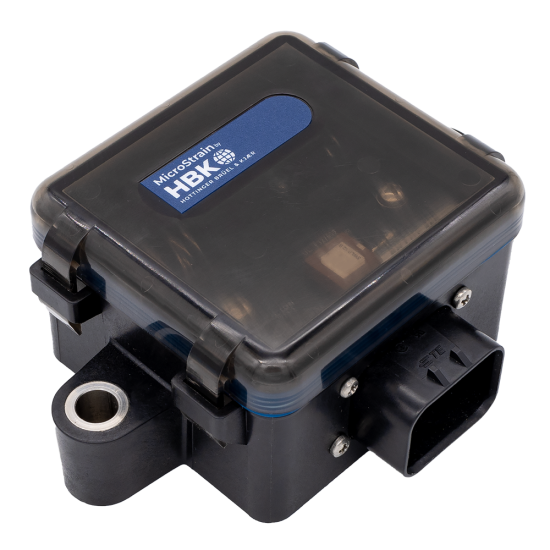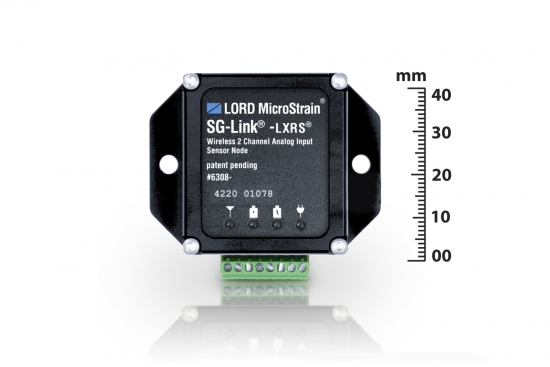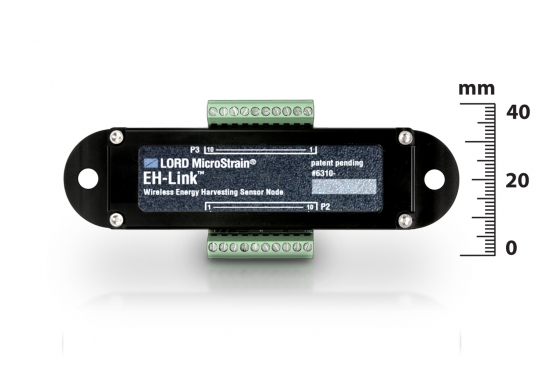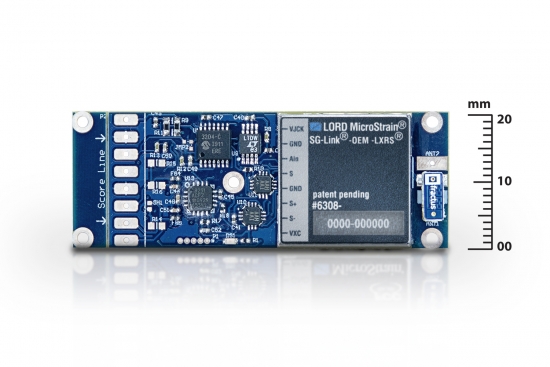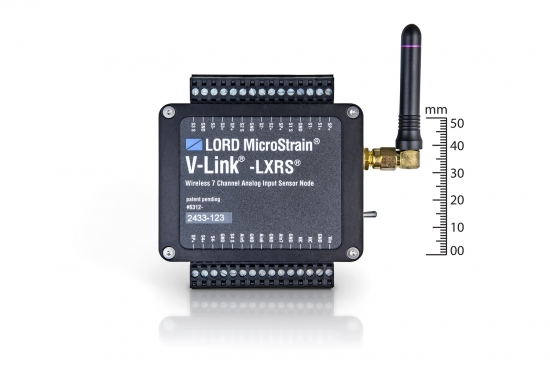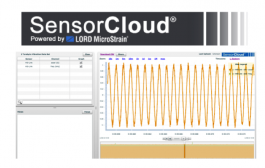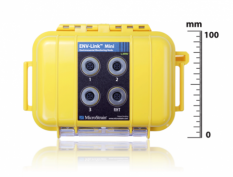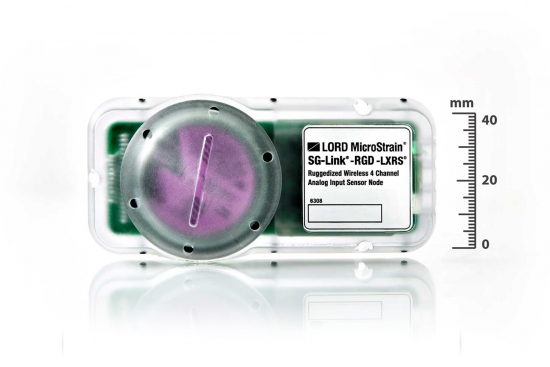Lord wireless sensor networks are fast to deploy and provide reliable, lossless data throughput. These networks are proven to work in demanding industries where reliable data acquisition is critical. Comes with replaceable batteries.
Additionally, a digital pulse input channel allows easy integration to a hall effect sensor for reporting RPM or pulse count. The versatility and small form factor make the SG-Link-200-OEM easy to integrate into many applications.
Lord wireless sensor networks are fast to deploy and provide reliable, lossless data throughput. These networks are proven to work in demanding industries where reliable data acquisition is critical. Comes with replaceable batteries.
The SG-Link® -LXRS® is a small, low-power, two-channel analog input sensor node with many sampling options.
Product Highlights
- One differential and one single-ended analog input channel and an internal temperature sensor
- Ideal for remote and long term measurement of many Wheatstone bridge and analog-type sensors including: strain, force, torque, pressure, acceleration, vibration, magnetic field, displacement and geophones
- Supports continuous, burst, and event-triggered sampling and datalogging to internal memory
- User-programmable sample rates up to 4096 Hz
- IP65/66 environmental enclosures available
The EH-Link™ is a versatile multi-sensor node that runs on ambient energy sources such as vibration, light, and inductance.
Product Highlights
- Sophisticated self-powered node can harvest energy from ambient energy sources for indefinite remote deployment.
- On-board high-speed triaxial accelerometer, internal temperature sensor, internal relative humidity sensor, and an analog input channel provide many sensing options.
- Supports auxiliary energy storage options such as super-capacitors and rechargeable thin film batteries
LORD MicroStrain® LXRS® Wireless Sensor Networks enable simultaneous, high- speed sensing and data aggregation from scalable sensor networks. Our wireless sensing systems are ideal for sensor monitoring, data acquisition, performance analysis, and sensing response applications.
The gateways are the heart of the LORD MicroStrain wireless sensing system. They coordinate and maintain wireless transmissions across a network of distributed wireless sensor nodes . The LORD MicroStrain LXRS wireless communication protocol between LXRS nodes and gateways enable high- speed sampling, ±32 microseconds node- to- node synchronization, transmission range up to 2 kilometers, and lossless data throughput under most operating conditions.
Users can easily program nodes for data logging, continuous, event- triggered, and periodic burst sampling with the Node Commander ® software. The web- based SensorCloud™ interface optimizes data aggregation, analysis, presentation, and alerts for gigabytes of sensor data from remote networks.
Datasheet Manual
The SG-Link®-OEM-LXRS® is a small, wireless, low-cost, extended range, two-channel analog input sensor node ready for OEM integration.
Product Highlights
- One differential and one single-ended analog input channel and an internal temperature sensor
- Ideal for remote and long term measurement of many Wheatstone bridge and analog-type sensors including: strain, force, torque, pressure, acceleration, vibration, magnetic field, displacement and geophones
- Supports continuous, burst, and event-triggered sampling and datalogging to internal memory
- User-programmable sample rates up to 4096 Hz
- Comprehensive SDK and OEM form factor for rapid integration
- Simultaneously transmit real-time data and log to memory
The V-Link® -LXRS® is a versatile seven channel analog wireless sensor node with high sample rates and datalogging capability.
Product Highlights
- Four differential and three single-ended analog input channels and an internal temperature sensor
- Ideal for remote and long term measurement of many Wheatstone bridge and analog-type sensors including: strain, force, torque, pressure, acceleration, vibration, magnetic field, displacement and geophones
- Supports continuous, burst, and event-triggered sampling and datalogging to internal memory
- l User-programmable sample rates up to 10 KHz
- l IP65/66 environmental enclosures available
MicroStrain’s SensorCloud™ is a unique sensor data storage, visualization and remote management platform that leverages powerful cloud computing technologies to provide excellent data scalability, rapid visualization, and user programmable analysis. Originally designed to support long-term deployments of MicroStrain wireless sensors, SensorCloud now supports any web-connected third party device, sensor, or sensor network through a simple OpenData API.
- Core SensorCloud features include: Virtually unlimited data storage with triple-redundant reliability, ideal for collecting and preserving long-term sensor data streams
- Time series visualization & graphing tool with exceptionally fast response, allows viewers to navigate through massive amounts of data, and quickly zero in on points of interest
- MathEngine® feature allows users to quickly develop and deploy data processing and analysis apps that live alongside their data in the cloud
- Flexible SMS and email alert scripting features helps users to create meaningful and actionable alerts.
To sign up for a free account, click here.
Overview
SensorCloud is useful for a variety of applications, particularly where data from large sensor networks needs to be collected, viewed, and monitored remotely. Structural health monitoring and condition based monitoring of high value assets are applications where commonly available data tools often come up short in terms of accessibility, data scalability, programmability, or performance. MicroStrain’s SensorCloud was born out of a need for a better tool for these types of applications but the core features and benefits can add value to a much broader range of applications.
Datasheet ManualThe SG-Link® -RGD -LXRS® ia a versatile, ruggedized four-channel analog sensor node with integrated triaxial accelerometer.
Product Highlights
- Four analog input channels, integrated three-axis accelerometer, and an internal temperature sensor
- Integrated strain sensor signal conditioning, embedded processing, and environmentally hardened form factor ideal for permanently mounting over strain gauges
- Supports conventional bonded foil, piezoelectric-resistive, Wheatstone bridge, and modular Columbia Research
- Labs-type strain gauges
- Integrated triaxial accelerometer with MEMS technology and +/- 16 g range
- User-programmable sample rates up to 4096 Hz
LORD MicroStrain® LXRS® Wireless Sensor Networks enable simultaneous, high- speed sensing and data aggregation from scalable sensor networks. Our wireless sensing systems are ideal for sensor monitoring, data acquisition, performance analysis, and sensing response applications.
The gateways are the heart of the LORD MicroStrain wireless sensing system. They coordinate and maintain wireless transmissions across a network of distributed wireless sensor nodes . The LORD MicroStrain LXRS wireless communication protocol between LXRS nodes and gateways enable high- speed sampling, ±32 microseconds node- to- node synchronization, transmission range up to 2 kilometers, and lossless data throughput under most operating conditions.
Users can easily program nodes for data logging, continuous, and periodic burst sampling with the Node Commander ® software. The web- based SensorCloud™ interface optimizes data aggregation, analysis, presentation, and alerts for gigabytes of sensor data from remote networks.
The SG-Link® -RGD -LXRS® ia a versatile, ruggedized four-channel analog sensor node with integrated triaxial accelerometer.
Product Highlights
- Four analog input channels, integrated three-axis accelerometer, and an internal temperature sensor
- Integrated strain sensor signal conditioning, embedded processing, and environmentally hardened form factor ideal for permanently mounting over strain gauges
- Supports conventional bonded foil, piezoelectric-resistive, Wheatstone bridge, and modular Columbia Research
- Labs-type strain gauges
- Integrated triaxial accelerometer with MEMS technology and +/- 16 g range
- User-programmable sample rates up to 4096 Hz
Wireless Simplicity, Hardwired Reliability
High Performance
- Scalable, long range wireless sensor networks up to 2 km
- Lossless data throughput under most operating conditions
Ease of Use
- Rapid deployment with wireless framework
- Low power consumption allows extended use.
- Remotely configure nodes, acquire and view sensor data with Node Commander®.
- Optional web-based SensorCloud™ interface optimizes data storage, viewing, and analysis.
- Easy integration via comprehensive SDK
Cost Effective
- Out-of-the box wireless sensing solution reduces development and deployment time.
- Volume discounts
Wireless Simplicity, Hardwired Reliability™
High Performance
- Potential power sources include: solar energy (photovoltaic); electromagnetic fields (electrodynamic); thermal energy from temperature changes (thermoelectric); strain and vibration (piezoelectric); high impact energy, and capacitive discharge.
- Solar energy harvesting input operates in low light levels.
- Thermal energy harvesting input operates in thermal gradients below 8 ˚C when used with Peltier Thermoelectric Generators (TEGs).
- User-programmable sample rates up to 512 Hz
Ease of Use
- Scalable, wireless sensor networks up to 70 m
- Easy out-of-the-box wireless sensing for most analog sensors
Wireless Simplicity, Hardwired Reliability
High Performance
- Scalable, long range wireless sensor networks up to 2 km
- Lossless data throughput under most operating conditions
Ease of Use
- Rapid deployment with wireless framework
- Low power consumption allows extended use.
- Wide range of sample rates and duty cycles
- Optional web-based SensorCloud™ interface optimizes data storage, viewing, and analysis.
Cost Effective
- Out-of-the box wireless sensing solution reduces development and deployment time.
- Volume discounts
Wireless Simplicity, Hardwired Reliability
High Performance
- Node-to-node synchronization up to ±32 microseconds
- High resolution data with 16-bit A/D converter
- Scalable, long range wireless sensor networks up to 2 km
- Lossless data throughput under most operating conditions
Ease of Use
- Rapid deployment with wireless framework
- Event driven triggers for efficient monitoring
- Remotely configure nodes, acquire and view sensor data with Node Commander®.
- Optional web-based SensorCloud™ interface optimizes data storage, viewing, and analysis.
- Easy integration via comprehensive SDK
Cost Effective
- Reduction of costs associated with wiring
- Low-cost per channel with 7 input channels per node
Key features of SensorCloud include:
- OpenData API: Allows users to securely upload sensor data from any web-connected source or platform, and download selected or entire sets of data
- FastGraph: Time series visualization & graphing tool with exceptionally fast response allows viewers to navigate through massive amounts of data, and quickly zero in on points of interest
- Custom Alerts: Flexible SMS and email alert scripting features helps users to create meaningful and actionable alerts
- LiveConnect: Allows remote configuration, viewing, and record high speed data streams from any wireless sensor cluster on your Ethernet network in real-time
- MathEngine: Enables users to quickly develop and deploy data processing and analysis apps that live alongside their data in the cloud
Wireless Simplicity, Hardwired Reliability
High Performance
- Node-to-node synchronization up to ±32 microseconds
- High resolution data with 16-bit A/D converter
- Scalable, long range wireless sensor networks up to 2 km
Ease of Use
- Flex bonding cable and node form factor allow quick installation over existing strain gauges
- Low profile, environmentally sealed enclosure
- On-board shunt calibration
Cost Effective
- Reduction of costs associated with wiring
- Out-of-the box wireless sensing solution reduces development and deployment time.
Wireless Simplicity, Hardwired Reliability
High Performance
- Node-to-node synchronization up to ±32 microseconds
- High resolution data with 16-bit A/D converter
- Scalable, long range wireless sensor networks up to 2 km
Ease of Use
- Flex bonding cable and node form factor allow quick installation over existing strain gauges
- Low profile, environmentally sealed enclosure
- On-board shunt calibration
Cost Effective
- Reduction of costs associated with wiring
- Out-of-the box wireless sensing solution reduces development and deployment time.
Sensor Input
- Four ±156 mV differential input channels
- Four ±10.24 V single-ended input channels
- 4.096 V sensor power output
- Adjustable gain for differential inputs (16 to 2048)
- Adjustable anti-aliasing filter for differential inputs
- High resolution 18-bit data
- Compatible with 120, 350, and 1kOhm Wheatstone bridge sensing circuits
- Available factory bridge completion on differential channels
- Remote strain calibration using on-board shunt resistor
- On-board temperature sensor (±0.3°C)
Operation
- Up to 4 kHz continuous sampling rate
- Continuous, periodic burst, or event-triggered operation
- LXRS protocol allows lossless data collection, scalable network size, and node synchronization of ±50 µs
- Datalogging up to 8 million data points
- Outdoor wireless range up to 1.5km
Package
- Internal batteries (4 x AA 3.6V LiSOCL2)
- External power (7.5 – 36 V)
- Bolt down or DIN-rail mounting
- –40 to +80 °C operating temperature range
- ESD: 4kV
Sensor Input
- 1 differential input channel
- 1 single-ended input channel
- 1 digital input for RPM or pulse counting
- On-board temperature sensor (+/- 0.25°C)
- 1.5 or 2.5 V sensor power output
- Adjustable gain (1 to 128)
- Adjustable filtering
- High resolution 24-bit data
- Noise as low as 1 µV p-p
- Compatible with 120, 350, and 1kOhm Wheatstone bridge sensing circuits
- Available factory bridge completion (¼, ½, or full-bridge)
- Remote strain calibration using on-board shunt resistor
Operation
- Up to 1 kHz continuous sampling rate
- Continuous, periodic burst, or event-triggered operation
- Output waveform data and/or derived parameters (Mean, RMS, peak-peak)
- LXRS protocol allows lossless data collection, scalable network size, and node synchronization of ±50 µs
- Datalogging up to 8 million data points
- Wireless range up to 1km
- Duty cycle sensor excitation for low power operation, well-suited for battery powered applications
Package
- Power with 3.3 to 30 VDC
- –40 to +105 °C operating temperature range
- Humiseal 1B31 Conformal Coating
- 4 mounting holes sized for 2-56 UNC
- Optional aluminum base and sensor terminal
- Antenna options include on-board, or U.FL connector
Sensor Input
- 3 differential input channels
- Temperature sensor
- 1.5 or 2.5 V sensor power output
- Adjustable gain (1 to 128)
- Adjustable filtering
- High resolution 24-bit data
- Noise as low as 1 µV p-p
- Compatible with 120, 350, and 1kOhm Wheatstone bridge sensing circuits
- Available factory bridge completion (¼, ½, or full-bridge)
- Remote strain calibration using on-board shunt resistor
Operation
- Up to 1 kHz continuous sampling rate
- Continuous, periodic burst, or event-triggered operation
- Output waveform data and/or derived parameters (Mean, RMS, peak-peak)
- LXRS protocol allows lossless data collection, scalable network size, and node synchronization of ±50 µs
- Datalogging up to 8 million data points
- Wireless range up to 1km
- Duty cycle sensor excitation for low power operation, well-suited for battery powered applications
Package
- Weatherproof IP-68
- Mount with 2 x M8 screws or 3M VHB 4941
- Stainless steel compression limiters
- Mating Connector - AMPSEAL 14-pin connector mates with TE776273-1
- –40 to +85 °C operating temperature range
- Power with D-cell battery or input 4 to 36 VDC
|
General |
|
|---|---|
|
Sensor input channels |
Differential analog, 1 channel Single-ended analog, 1 channel |
|
Integrated sensors |
Internal temperature, 1 channel |
|
Data storage capacity |
2 M bytes (up to 1,000,000 data points, data type dependent) |
|
Analog Input Channels |
|
|
Measurement range |
Differential: full-bridge, ≥ 350 Ω (factory configurable) Single-ended: 0 to 3 V dc |
|
Accuracy |
± 0.1% full scale typical |
|
Resolution |
12 bit |
|
Anti-aliasing filter bandwidth |
Single-pole Butterworth -3 dB cutoff @ 250 Hz (factory configurable) |
|
Bridge excitation voltage |
+3 V dc, 50 mA total for all channels (pulsed @ sample rates ≤ 16 Hz to conserve power) |
|
Measurement gain and offset |
User-selectable in software on differential channels gain values from 104 to 1800 |
|
Integrated Temperature Channel |
|
|
Measurement range |
-40 °C to 85 °C |
|
Accuracy |
± 2 °C (at 25 °C) typical |
|
Resolution |
12 bit |
|
Sampling |
|
|
Sampling modes |
Synchronized, low duty cycle, datalogging |
|
Sampling rates |
Continuous sampling: 1 sample/hour to 512 Hz Periodic burst sampling: 32 Hz to 4096 Hz Datalogging: 32 Hz to 4096 Hz |
|
Sample rate stability |
± 3 ppm |
|
Network capacity |
Up to 2000 nodes per RF channel (and per gateway) depending on the number of active channels and sampling settings. Refer to the system bandwidth calculator: http://www.microstrain.com/configure-your-system |
|
Synchronization between nodes |
± 32 μsec |
|
Operating Parameters |
|
|
Radio frequency (RF) transceiver carrier |
2.405 to 2.470 GHz direct sequence spread spectrum over 14 channels, license free worldwide, radiated power programmable from 0 dBm (1 mW) to 16 dBm (39 mW); low power option available for use outside the U.S.- limited to 10dBm (10mW) |
|
Range for bi-directional RF link |
70 m to 2 km line of sight with RF power setting |
|
RF communication protocol |
IEEE 802.15.4 |
|
Power source |
Internal: 3.7 V dc, 250 mAh lithium ion rechargeable battery External: +3.2 to +9.0 V dc |
|
Power consumption |
See power profile : |
|
Operating temperature |
-20 ˚C to + 60 ˚C (extended temperature range available with custom battery/enclosure, -40 ˚C to + 85 ˚C electronics only) |
|
Acceleration limit |
500 g standard (high g option available) |
|
Physical Specifications |
|
|
Dimensions |
58 mm x 50 mm x 21 mm |
|
Weight |
42 grams |
|
Environmental rating |
Indoor use (IP65/66 enclosures available) |
|
Enclosure material |
ABS plastic |
|
Integration |
|
|
Compatible gateways |
All WSDA® base stations and gateways |
|
Compatible sensors |
Bridge type analog sensors, 0 to 3 V dc analog sensors |
|
Connectors |
Screw terminal block |
|
Shunt calibration |
Internal shunt calibration resistor 499 KΩ, differential channel |
|
Software |
SensorCloud™, SensorConnect™, Node Commander®, Windows 7 (or newer) |
|
Software development |
Open-source MicroStrain Communications Library (MSCL) with sample code available in C++,Python,and.NET formats (OS and computing platform independent): http://lord-microstrain.github.io/MSCL/ |
|
Regulatory compliance |
FCC (U.S.), IC (Canada), ROHS |
|
General |
|
|---|---|
|
Sensor input channels |
Energy harvesting, 3 source types and channels Differential analog, 1 channel |
|
Integrated sensors |
Triaxial MEMS accelerometer, 3 channels Internal temperature, 1 channel Relative humidity, 1 channel |
|
Energy Harvesting Inputs |
|
|
Wide range voltage (WRV) input |
5 to 20 V ac/dc peak, (piezoelectric, electrodynamic, photovoltaic, electromagnetic) |
|
Capacitive discharge voltage (CDV) input |
20 to 130 V ac (pulsed piezoelectric) |
|
Ultra-low voltage (ULV) input |
20 to 600 mV dc (thermoelectric, Peltier, thermopile) |
|
Analog Input Channel |
|
|
Measurement range |
Differential: full-bridge, ≥ 350 Ω (factory configurable), user programmable gain and offset |
|
Accuracy and resolution |
± 0.1% full scale typical, 12 bit resolution |
|
Bridge excitation voltage |
+2.7 V dc, 50 mA (pulsed @ sample rates ≤ 16 Hz to conserve power) |
|
Integrated Accelerometer Channels |
|
|
Measurement range |
± 16 g |
|
Accuracy and resolution |
± 4 mg, 12 bit resolution |
|
Integrated Temperature Channel |
|
|
Measurement range |
-40 °C to 85 °C |
|
Accuracy and resolution |
± 2 °C (at 25 °C) typical , 12 bit resolution |
|
Integrated Relative Humidity (RH) Channel |
|
|
Measurement range |
0 to 100 % |
|
Accuracy |
± 2 % (10 to 90 % RH), ± 4 % ( 0 to 10% RH and 90 to 100% RH) |
|
Repeatability |
± 0.1 % |
|
Sampling |
|
|
Sampling modes |
Low duty cycle |
|
Sampling rates |
Continuous sampling: 1 Hz to 512 Hz |
|
Sample rate stability |
± 3 ppm |
|
Network capacity |
Up to 2000 nodes per RF channel (and per gateway) depending on the number of active channels and sampling settings. |
|
Operating Parameters |
|
|
Radio frequency (RF) transceiver carrier |
2.405 to 2.470 GHz direct sequence spread spectrum over 14 channels, license-free worldwide, radiated power 0 dBm |
|
RF communication protocol |
IEEE 802.15.4 |
|
Range for bi-directional RF link |
70 m line of sight |
|
Energy use |
Startup: 12 μJ; sampling: accelerometer or RH sensor only, 105 μJ/sample; sampling: differential input only, 168 μJ/sample; data transmission: 92.4 μJ/packet |
|
Operating temperature |
-20 ˚C to + 60 ˚C |
|
Operating humidity |
0 to 95 %, non-condensing |
|
Acceleration limit |
500 g standard |
|
Physical Specifications |
|
|
Dimensions |
88 mm x 39 mm x 16 mm |
|
Weight |
26 grams |
|
Integration |
|
|
Compatible gateways |
All WSDA® base stations and gateways |
|
Compatible sensors |
Bridge type analog sensors (for analog inputs) |
|
Connectors |
Screw terminal blocks |
|
Software |
SensorCloud™, Node Commander®, WSDA® Data Downloader, Live Connect™, Windows XP/Vista/7 compatible |
|
Software development kit (SDK) |
Data communications protocol available with EEPROM maps and sample code (OS and computing platform independent) http://www.microstrain.com/software-development-kits-sdks |
|
Regulatory compliance |
ROHS |
|
General |
|
|---|---|
|
Sensor input channels |
Differential analog, 1 channel Single-ended analog, 1 channel |
|
Integrated sensors |
Internal temperature, 1 channel |
|
Data storage capacity |
2 M bytes (up to 1,000,000 data points, data type dependent) |
|
Analog Input Channels |
|
|
Measurement range |
Differential: full-bridge, ≥ 350 Ω (factory configurable) Single-ended: 0 to 3 V dc |
|
Accuracy |
± 0.1% full scale typical |
|
Resolution |
12 bit |
|
Anti-aliasing filter bandwidth |
Single-pole Butterworth -3 dB cutoff @ 250 Hz (factory configurable) |
|
Bridge excitation voltage |
+3 V dc, 50 mA total for all channels (pulsed @ sample rates ≤ 16 Hz to conserve power) |
|
Measurement gain and offset |
User-selectable in software on differential channels gain values from 104 to 2560 |
|
Integrated Temperature Channel |
|
|
Measurement range |
-40 °C to 85 °C |
|
Accuracy |
± 2 °C (at 25 °C) typical |
|
Resolution |
12 bit |
|
Sampling |
|
|
Sampling modes |
Synchronized, low duty cycle, datalogging |
|
Sampling rates |
Continuous sampling: 1 sample/hour to 512 Hz Periodic burst sampling: 32 Hz to 4096 Hz Datalogging: 32 Hz to 4096 Hz |
|
Sample rate stability |
± 3 ppm |
|
Network capacity |
Up to 2000 nodes per RF channel (and per gateway) depending on the number of active channels and sampling settings. Refer to the system bandwidth calculator: http://www.microstrain.com/configure-your-system |
|
Synchronization between nodes |
± 32 μsec |
|
Operating Parameters |
|
|
Radio frequency (RF) transceiver carrier |
2.405 to 2.470 GHz direct sequence spread spectrum over 14 channels, license free worldwide, radiated power programmable from 0 dBm (1 mW) to 16 dBm (39 mW); low power option available for use outside the U.S.- limited to 10dBm (10mW) |
|
Range for bi-directional RF link |
70 m to 2 km line of sight with RF power setting |
|
RF communication protocol |
IEEE 802.15.4 |
|
Power source |
External: +3.2 to +9.0 V dc (9 V dc alkaline battery provided) |
|
Power consumption |
See power profile : http://files.microstrain.com/SG-Link-OEM- LXRS-Power-Profile.pdf |
|
Operating temperature |
-40 ˚C to + 85 ˚C (excluding 9 V battery) |
|
Acceleration limit |
500 g standard (high g option available) |
| MTBF | 1,300,000 hours (Telcordia method, SR332) |
|
Physical Specifications |
|
|
Dimensions |
56 mm x 20 mm x 6 mm |
|
Weight |
7 grams |
|
Integration |
|
|
Compatible gateways |
All WSDA® base stations and gateways |
|
Compatible sensors |
Bridge type analog sensors, 0 to 3 V dc analog sensors |
|
Connectors |
Solder pads or screw terminal connector |
|
Shunt calibration |
Internal shunt calibration resistor 499 KΩ, differential channel |
|
Software |
SensorCloud™, SensorConnect™, Node Commander®, Windows 7 (or newer) |
|
Software development |
Open-source MicroStrain Communications Library (MSCL) with sample code available in C++,Python,and.NET formats (OS and computing platform independent): http://lord-microstrain.github.io/MSCL/ |
|
Regulatory compliance |
FCC (U.S.), IC (Canada), ROHS |
| General | |
|---|---|
|
Sensor input channels |
Differential analog, 4 channels Single-ended analog, 3 channels |
|
Integrated sensors |
Internal temperature, 1 channel |
|
Data storage capacity |
4 M bytes (up to 2,000,000 data points, data type dependent) |
| Analog Input Channels | |
|
Measurement range |
Differential: full-bridge, ≥ 350 Ω (factory configurable) Single-ended: 0 to 3 V dc |
|
Accuracy |
± 0.1% full scale typical |
|
Resolution |
16 bit |
|
Anti-aliasing filter bandwidth |
Single-pole Butterworth -3 dB cutoff @ 250 Hz (factory configurable) |
|
Bridge excitation voltage |
+3 V dc, 50 mA total for all channels (pulsed @ sample rates ≤ 16 Hz to conserve power) |
|
Measurement gain and offset |
User-selectable in software on differential channels gain values from 21 to 13074 |
| Integrated Temperature Channel | |
|
Measurement range |
-40 °C to 85 °C |
|
Accuracy |
± 2 °C (at 25 °C) typical |
|
Resolution |
16 bit |
| Sampling | |
|
Sampling modes |
Synchronized, low duty cycle, datalogging, event-triggered |
|
Sampling rates |
Continuous sampling: 1 sample/hour to 512 Hz Periodic burst sampling: 32 Hz to 10 KHz Datalogging: 32 Hz to 10 KHz |
|
Sample rate stability |
± 3 ppm |
|
Network capacity |
Up to 2000 nodes per RF channel (and per gateway) depending on the number of active channels and sampling settings. Refer to the system bandwidth calculator: http://www.microstrain.com/configure-your-system |
|
Synchronization between nodes |
± 32 μsec |
| Operating Parameters | |
|
Radio frequency (RF) transceiver carrier |
2.405 to 2.470 GHz direct sequence spread spectrum over 14 channels, license free worldwide, radiated power programmable from 0 dBm (1 mW) to 16 dBm (39 mW); low power option available for use outside the U.S.- limited to 10dBm (10mW) |
|
Range for bi-directional RF link |
Outdoor/line-of-sight: 2 km (ideal) *, 800 m (typical)** Indoor/obstructions: 50 m (typical)** |
|
RF communication protocol |
IEEE 802.15.4 |
|
Power source |
Internal: 3.7 V dc, 650 mAh lithium ion rechargeable battery External: +3.2 to +9.0 V dc |
|
Power consumption |
See power profile : |
|
Operating temperature |
-20 ˚C to + 60 ˚C (extended temperature range available with custom battery/enclosure, -40 ˚C to + 85 ˚C electronics only) |
|
Acceleration limit |
500 g standard (high g option available) |
| Physical Specifications | |
|
Dimensions |
74 mm x 79 mm x 21 mm |
|
Weight |
141 grams |
|
Environmental rating |
Indoor use (IP65/66 enclosures available) |
|
Enclosure material |
Anodized aluminum |
| Integration | |
|
Compatible gateways |
All WSDA® base stations and gateways |
|
Compatible sensors |
Bridge type analog sensors, 0 to 3 V dc analog sensors |
|
Connectors |
Screw terminal block |
|
Shunt calibration |
Internal shunt calibration resistor 499 KΩ, differential channels |
|
Software |
SensorCloud™, Node Commander®, Windows XP/Vista/7 |
|
Software development |
Open-source MicroStrain Communications Library (MSCL) with sample code available in C++,Python,and.NET formats (OS and computing platform independent): http://lord-microstrain.github.io/MSCL/ |
|
Regulatory compliance |
FCC (U.S.), IC (Canada), CE, ROHS |
*Measured with antennas elevated, no obstructions, and no RF interferers.
**Actual range varies depending on conditions such as obstructions, RF interference, antenna height, & antenna orientation.
|
General |
|
|---|---|
|
Sensor input channels |
RHT sensor input, 1 channel each (temperature and humidity) 0 to 5 V dc inputs, 3 channels |
|
Data storage capacity |
2 M bytes (up to 500,000 data points) |
|
Relative Humidity and Temperature (RHT) Sensor Input |
|
|
Measurement range |
0 to 100 % RH, -40 °C to 123 °C |
|
Accuracy (RH) |
± 2 % (10 to 90 % RH), ± 4 % ( 0 to 10% RH and 90 to 100% RH) |
|
Accuracy (temperature) |
± 0.3 °C typical |
|
Resolution |
12 bit |
|
0 to 5 V DC inputs |
|
|
Measurement range |
0 to 5 V dc |
|
Accuracy |
0.01 % typical (absolute accuracy) |
|
Resolution |
24 bit |
|
Sensor excitation |
2 or 3 V dc (user selectable) |
|
Sampling |
|
|
Sampling modes |
Synchronized, low duty cycle, datalogging |
|
Sampling rates |
Continuous sampling: 1 sample/hour to 2 Hz Datalogging:1 sample/hour to 2 Hz |
|
Sample rate stability |
± 3 ppm |
|
Network capacity |
Up to 2000 nodes per RF channel (and per gateway) depending on the number of active channels and sampling settings. Refer to the system bandwidth calculator: http://www.microstrain.com/configure-your-system |
|
Synchronization between nodes |
± 32 μsec |
|
Operating Parameters |
|
|
Radio frequency (RF) transceiver carrier |
2.405 to 2.470 GHz direct sequence spread spectrum over 14 channels, license free worldwide, radiated power programmable from 0 dBm (1 mW) to 16 dBm (39 mW); low power option available for use outside the U.S.A.- limited to 10 dBm (10 mW) |
|
RF communication protocol |
IEEE 802.15.4 |
|
Range for bi-directional RF link |
70 m to 2 km line of sight with RF power setting |
|
Power source |
Internal: size D-cell 3.6 V dc Lithium thionyl chloride batteries (included), or size D-cell 1.5 V dc alkaline batteries (user supplied); External: 0.9 V dc to 6.0 V dc |
|
Power consumption |
See power profile :http://files.microstrain.com/ENV-Link-Mini- LXRS-Power-Profile.pdf |
|
Operating temperature |
-40 ˚C to + 85 ˚C (with Lithium thionyl chloride batteries) |
|
Physical Specifications |
|
|
Dimensions |
150 mm x 53 mm x 100 mm |
|
Weight |
298 grams |
|
Environmental rating |
IP67 |
|
Enclosure material |
polycarbonate |
|
Integration |
|
|
Compatible gateways |
All WSDA® base stations and gateways |
|
Compatible sensors |
RHT input: LORD MicroStrain® RHT sensor 0 to 5 V dc inputs: pyranometer, photosynthetic photon flux, soil moisture, and leaf wetness sensors (available from LORD MicroStrain® ), thermocouples, rain and strain gauges, anemometers, and other 0 to 5 V dc sensors |
|
Connectors |
M9 screw-on IP67 connector |
|
Software |
SensorCloud™, Node Commander®, WSDA® Data Downloader, Live Connect™, Windows XP/Vista/7 compatible |
|
Software development kit (SDK) |
Data communications protocol available with EEPROM maps and sample code (OS and computing platform independent) http://www.microstrain.com/software-development-kits-sdks |
|
Regulatory compliance |
FCC (U.S.), IC (Canada), ROHS |
| General | |
|---|---|
|
Sensor input channels |
Differential analog, 4 channels |
|
Integrated sensors |
Triaxial MEMS accelerometer, 3 channels Internal temperature, 1 channel |
|
Data storage capacity |
2 M bytes (up to 1,000,000 data points, data type dependent) |
| Analog Input Channels | |
|
Measurement range |
Differential: full-bridge, ≥ 350 Ω (factory configurable) |
|
Accuracy and resolution |
± 0.1% full scale typical, 16 bit resolution |
|
Anti-aliasing filter bandwidth |
Single-pole Butterworth -3 dB cutoff @ 250 Hz |
|
Bridge excitation voltage |
+2.7 V dc, 50 mA total for all channels (pulsed @ sample rates ≤ 16 Hz to conserve power) |
|
Measurement gain and offset |
User-selectable in software on differential channels gain values from 104 to 1800 |
| Integrated Accelerometer Channels | |
|
Measurement range |
± 16 g |
|
Accuracy and resolution |
± 4 mg, 13 bit resolution |
| Integrated Temperature Channel | |
|
Measurement range |
-40 °C to 85 °C |
|
Accuracy and resolution |
± 2 °C (at 25 °C) typical, 16 bit resolution |
| Sampling | |
|
Sampling modes |
Synchronized, low duty cycle, datalogging |
|
Sampling rates |
Continuous sampling: 1 sample/hour to 512 Hz Periodic burst sampling: 32 Hz to 4096 Hz Datalogging: 32 Hz to 4096 Hz |
|
Sample rate stability |
± 3 ppm |
|
Network capacity |
Up to 2000 nodes per RF channel (and per gateway) depending on the number of active channels and sampling settings. Refer to the system bandwidth calculator: http://www.microstrain.com/configure-your-system |
|
Synchronization between nodes |
± 32 μsec |
| Operating Parameters | |
|
Radio frequency (RF) transceiver carrier |
2.405 to 2.470 GHz direct sequence spread spectrum over 14 channels, license free worldwide, radiated power programmable from 0 dBm (1 mW) to 16 dBm (39 mW); low power option available for use outside the U.S.- limited to 10dBm (10mW) |
|
Range for bi-directional RF link |
70 m to 2 km line of sight with RF power setting |
|
RF communication protocol |
IEEE 802.15.4 |
|
Power source |
Replaceable 3.7 V dc, 1.7 Ah Tadiran TL-5935 1/6 D-cell battery |
|
Power consumption |
960 uA ( 3.46 mW) @ 3.6 V dc, 32 HZ, 3 ch, no duty cycling 10.6 mA (38.16 mW) @ 3.6 V dc, 256 Hz, 3 ch, no duty cycling 4.0 mA (14.4 mW) @ 3.6 V dc, 256 Hz, 1 ch, no duty cycling |
|
Operating temperature |
-40 ˚C to + 85 ˚C |
|
Acceleration limit |
500 g standard (high g option available) |
| Physical Specifications | |
|
Dimensions |
101 mm x 46 mm x 26 mm |
|
Weight |
150 g (including battery) |
|
EMI/EMC rating |
MIL-STD-461F |
|
Enclosure material |
Clear polycarbonate |
| Integration | |
|
Compatible gateways |
All WSDA® base stations and gateways |
|
Compatible sensors> |
Bridge type analog sensors |
|
Connectors |
Flex cable terminal/solder pads (flex cable included) |
|
Shunt calibration |
Internal shunt calibration resistor 499 KΩ, differential channels< |
|
Software< |
SensorCloud™, SensorConnect™, Node Commander®, Windows 7 (or newer) |
|
Software development |
Open-source MicroStrain Communications Library (MSCL) with sample code available in C++,Python,and.NET formats (OS and computing platform independent): http://lord-microstrain.github.io/MSCL/ |
|
Regulatory compliance |
FCC (U.S.), IC (Canada), ROHS |
General Documentation
General Documentation
General Documentation
General Documentation
- SG-Link®-LXRS® Product Datasheet
- SG-Link®-LXRS® Quick Start Guide
- SG-Link®-LXRS® User Manual
- Node Commander Wireless Sensing Software User Manual
- Wireless Products Comparison
Technical Notes
- Powering a Wireless Node with Sources Greater Than 9 Volts
- Measuring Voltages Above 3 Volts with SG-Link®-LXRS®
- Using a Load Cell with SG-Link®-LXRS®
- LXRS® Firmware Upgrades
- Control a Relay with a Wireless Node
- Measuring Small Current
- Outputting a 4 to 20 mA Current Loop
- Using Pressure Transducers
- Battery Use and Replacement
- SG-Link® 350 Ohm Tester Board
- SG-Link® 1000 Ohm Tester Board
- IP and NEMA Rated Enclosures for Wireless Nodes
- SG-Link®-LXRS™ Power Profile
- Wireless Sensor Node Power Profiles
- Using External Power With Wireless Sensor Nodes
- Using the DEMOD-DC® with V-Link®-LXRS® and SG-Link®-LXRS®
- Synchronized Sampling on Startup
- Differential Analog Input Frequency Response Testing
- Distance Measurement with an IR Sensor
- Using Differential Inputs for a RTD
Mechanical Drawings (uncontrolled)
- SG-Link®-LXRS® Dimensional Drawing
- 6309-3000 SG-Link-IP66-ENCL
- 6309-4000 SG-Link-IP66-XL-ENCL
- 6309-5000 SG-Link-IP65-XXL-ENCL
- 6309-3000 IP66/NEMA4X Enclosure for SG-Link®-LXRS®
- 6309-4000 IP66/NEMA4X Enclosure for SG-Link®-LXRS® (1 battery)
- 6309-5000 IP65/NEMA4X Enclosure for SG-Link®-LXRS® (3 batteries)
Videos
General Documentation
- EH-Link® Data Sheet
- EH-Link™ Quick Start Guide
- Node Commander Wireless Sensing Software User Manual
- Wireless Products Comparison
Technical Notes
- EH-Link™ Powered by Thermoelectric Generator
- EH-Link™ Powered by Indoor Solar Cell
- EH-Link™ Powered by Piezoelectric Source
Mechanical Drawings
FAQs
General Documentation
- SG-Link®-OEM-LXRS® Product Datasheet
- SG-Link®-OEM -LXRS® Quick Start Guide
- Node Commander Wireless Sensing Software User Manual
- Wireless Products Comparison
Software Development Kit
Technical Notes
- Powering a Wireless Node with Sources Greater Than 9 Volts
- LXRS® Firmware Upgrades
- Outputting a 4 to 20 mA Current Loop
- SG-Link®-OEM -LXRS® Power Profile
- Using Pressure Transducers
- Battery Use and Replacement
- SG-Link® 350 Ohm Tester Board
- SG-Link® 1000 Ohm Tester Board
- Using the DEMOD-DC® with V-Link®-LXRS® and SG-Link®-LXRS®
- Synchronized Sampling on Startup
- Distance Measurement with an IR Sensor
- Using Differential Inputs for a RTD
- Measuring Small Currents
Videos
- NC QSG #1 General Communications
- NC QSG #2 Node Configuration
- NC QSG #3 Real-Time Streaming
- NC QSG #4 Legacy Low Duty Cycle
- NC QSG #5 Synchronized Sampling
- NC QSG #6 Armed Data Logging
FAQ's
General Documentation
- V-Link®-LXRS® Product Manual
- V-Link®-LXRS® Product Datasheet
- V-Link®–LXRS® Quick Start Guide
- V-Link®-LXRS® Document of Conformity
- Node Commander Wireless Sensing Software User Manual
- Wireless Products Comparison
Technical Notes
- Powering a Wireless Node with Sources Greater Than 9 Volts
- High Cycle Vibration and Function Test
- Event Driven Sampling
- Measuring Voltages Above 3 Volts with V-Link®-LXRS®
- LXRS® Firmware Upgrades
- Using a 4 to 20 mA Pressure Transducer
- Control a Relay with a Wireless Node
- Measuring Small Current
- Measuring Small Voltages
- Outputting a 4 to 20 mA Current Loop
- Using Pressure Transducers
- Battery Use and Replacement
- V-Link®-LXRS® 350 Ohm Tester Board
- V-Link®-LXRS® 1000 Ohm Tester Board
- V-Link®-LXRS® Pin Assignments
- Using the 50g, 100g, 200g or 500g Triaxial Accelerometer Cube
- IP and NEMA Rated Enclosures for Wireless Nodes
- Calculating a Linear Slope with Microsoft Excel®
- Using a Load Cell with V-Link®-LXRS™ and SG-Link®-LXRS®
- V-Link®-LXRS® Power Profile
- Wireless Sensor Node Power Profiles
- Using External Power With Wireless Sensor Nodes
- Using the DEMOD-DC® with V-Link®-LXRS® and SG-Link®-LXRS®
- Synchronized Sampling on Startup
- Distance Measurement with an IR Sensor
- Using Differential Inputs for a RTD
Mechanical Drawings (Uncontrolled)
- V-Link®–LXRS® Dimensional Drawing
- 6313-3100 V-Link-IP66-XL-ENCL
- 6313-3100 IP66/NEMA4X Enclosure for V-Link®-LXRS® (2 batteries)
Videos
General Documentation
- ENV-Link™-Mini -LXRS® Datasheet
- ENV-Link™-Mini -LXRS® Sensors Datasheet
- ENV-Link™-Mini -LXRS® Quick Start Guide
- Node Commander Wireless Sensing Software User Manual
- MicroStrain Wireless Sensor Networks LXRS™ Data Communications Protocol
- Wireless Products Comparison
Software Development Kit
Technical Notes
- LXRS® Firmware Upgrades
- Outputting a 4 to 20 mA Current Loop
- ENV-Link™-Mini -LXRS® Power Profile
- Battery Use and Replacement
- Synchronized Sampling on Startup
Mechanical Prints (Uncontrolled)
FAQ's
General Documentation
- SG-Link® -RGD -LXRS® Datasheet
- Node Commander Wireless Sensing Software User Manual
- Wireless Products Comparison
Mechanical Drawings (Uncontrolled)
- SG-Link® -RGD -LXRS® Mechanical Drawing
- SG-Link® -RGD -LXRS® Accelerometer Orientation
- SG-Link® -RGD -LXRS® Wiring Diagram
Technical Notes
Software
- SensorConnect Data Acquisition Software (beta)
- Node Commander Data Acquisition Software
- MicroStrain Communication Library (MSCL)
- Software Systems Overview (link)
- SensorCloud Overview (link)
- MicroStrain SDK LabView Examples (legacy)
Firmware
Mechanical
